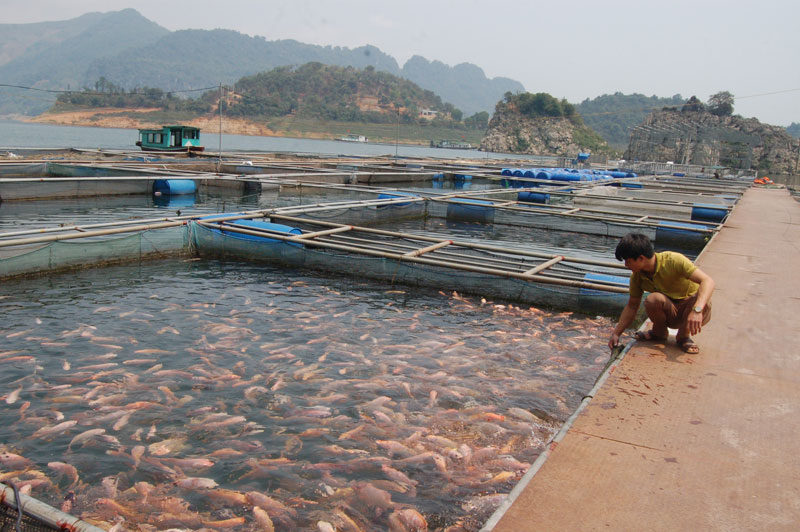
(HBO) – Hoa Binh farm produce trademark has become popular in recent years. It is the result of concerted efforts, including biotechnological application in agriculture.
 Da River fish joint
stock company is conducting research on specialty fish in Hoa Binh lake.
Da River fish joint
stock company is conducting research on specialty fish in Hoa Binh lake.
Further attention has been paid to the research and
application of biotechnology in producing plant and animal protection
probiotics. A number of probiotics and plant protection biomedicines have been
produced, making active contributions to fighting epidemics, preventing and
improving the health of producers and consumers. Several probiotics and
biological measures have been used widely such as E.M probiotics used for the
treatment of agricultural by-products such as straw, grass, corn and peanut stalks
to turn them into micro organic fertilisers, integrated pest management that
helps reduce pesticide residues and environment pollution.
The most outstanding result of biotechnology application in
agriculture is the renewal of crop and livestock structure that help improve
added value, cut workforce and enhance productivity.
Statistics by the provincial agriculture and rural
development sector showed that the total rice cultivation area that was switched
to other crops reached 7,524ha, up 2.5-fold from 2015. The area of renovated farms
neared 7,900ha, marking a 31-fold increase from 2015. The converted areas have
become concentrated production zones yielding high value with major crops such
as orange, sugarcane, chayote, zucchini and watermelon. High-quality
crossbreeds were put into production in large number such as blue beam, black
carp, among others.
Thanks to biotechnological application, the province has
developed several areas holding competitiveness such as Cao Phong orange and
mandarin, chayote vegetable, Tan Lac green-skinned pomelo, Luong Son zucchini
and Kim Boi longan. The province has so far had one geographical indication,
seven certified trademarks and 13 certified collective trademarks./.
According to data from the Hoa Binh Provincial Party Committee, the industrial production index for the first six months of 2025 is estimated to have increased by 20% compared to the same period last year. This marks the highest year-on-year growth rate for this period since 2020.
In the first six months of 2025, Hoa Binh province’s export turnover was estimated at 1.145 billion USD, marking an 18.11% increase compared to the same period in 2024. Import turnover was estimated at $ 804 million, a 17.15% increase, which helped the province maintain a positive trade balance.
The lives of the ethnic minority farmers in Tan Lac district have gradually improved thanks to the new directions in agricultural production. This is a testament to the collective strength fostered through the professional associations and groups implemented by various levels of the district’s Farmers’ Union.
With the motto the "product quality comes first,” after nearly one year of establishment and operation, Muong village’s Clean Food Agricultural and Commercial Cooperative, located in Cau Hamlet, Hung Son Commune (Kim Boi district), has launched reputable, high-quality agricultural products to the market that are well-received by consumers. The products such as Muong village’s pork sausage, salt-cured chicken, and salt-cured pork hocks have gradually carved out a place in the market and they are on the path to obtaining the OCOP certification.
In the past, the phrase "bumper harvest, rock-bottom prices" was a familiar refrain for Vietnamese farmers engaged in fragmented, small-scale agriculture. But today, a new spirit is emerging across rural areas of Hoa Binh province - one of collaboration, organisation, and collective economic models that provide a stable foundation for production.
Maintaining growing area codes and packing facility codes in accordance with regulations is a mandatory requirement for agricultural products to be eligible for export. Recently, the Department of Agriculture and Environment of Hoa Binh province has intensified technical supervision of designated farming areas and packing facilities to safeguard the "green passport" that enables its products to access international markets.



 Da River fish joint
stock company is conducting research on specialty fish in Hoa Binh lake.
Da River fish joint
stock company is conducting research on specialty fish in Hoa Binh lake.